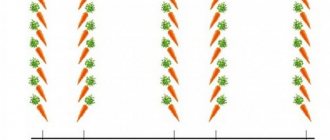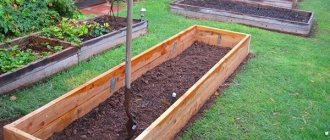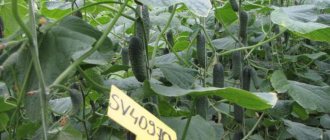Planting tomato seedlings in a greenhouse should be carried out according to all the rules, then it will be possible to get a tomato harvest much earlier than in open ground. It is very important to determine terms, time, favorable days, when and how to plant seedlings.
Only with proper planting of seedlings in a greenhouse can you get a rich tomato harvest in any growing region. The planting process has its own subtleties, which we will talk about later.
Dates and time of planting tomato seedlings in a greenhouse
The timing of planting seedlings in a greenhouse depends on the technical characteristics of the building:
- Heated - at the end of April.
- From polycarbonate or with additional film cover - in early May.
- Film - after May 15.
The age of the seedlings also plays a big role. Seedlings should have a well-developed root system and 6-8 true leaves. Also, seedlings must be hardened off. This is indicated by the dark color of the stem at the base.
Seedlings are ready for transplanting when the following indicators occur:
- age - 50 days;
- there are 7-10 true leaves.
You also need to pay attention to the air temperature.
Feeding tomatoes
All varieties of tomatoes require regular feeding
Such actions need to be performed only after the seedlings planted in the greenhouse have begun to grow. This will be evidenced by additional leaves on the trunk and rapid growth of the bush. So:
- As a rule, fertilizing (see How to fertilize tomatoes to get a rich harvest) is performed only twice. The first time after the seedlings take the soil in the greenhouse and the second time as soon as the fruits (sets) begin to appear. At one time, any fertilizing should use no more than 0.40-0.45 kg per 1 hectare of soil.
- Calcium or ammonium nitrate is used as a product and preferably in powder form - when the fertilization process is carried out after the seedlings have taken up the soil. This powder is sprinkled on the soil and watered. You can use these products in liquid form and apply them in the process of watering tomatoes.
Advice. The concentration of any solution for feeding tomatoes should not exceed 0.3%.
- You should not fertilize immediately after the seedlings begin to grow. You must first analyze the soil for the presence of nutrients in it. If they are present in sufficient quantities, then the first feeding can be canceled.
Advice. There are also some methods that involve feeding the root system directly. But, as practice has shown, it is best to apply fertilizers on top of the soil. In this case, the results can be seen two weeks earlier than the root one.
Optimal temperature and features of planting seedlings in the Moscow region, Siberia, the Urals and the North-West
You need to focus on the air and ground temperature:
- the air should warm up to +18-20 degrees;
- soil - up to +13-15 degrees. E
- At night the temperature should not fall below +10°C.
When these indicators are reached, tomato seedlings can be planted in the greenhouse.
The main thing is to do everything on time. There is no need to rush into deadlines, since at low air and soil temperatures, tomato growth slows down and seedlings take longer to recover.
The average daily air temperature should be at least +13 degrees. Planting of seedlings is carried out:
- in the Moscow region - May 1-15;
- in the Leningrad region - May 20-June 10;
- in the Urals and Siberia - from June 15.
The main thing is to look at the temperature indicators and the condition of the seedlings, and do not rush if there is still a risk of a strong drop in temperature.
Suitable conditions for growing tomatoes
A greenhouse differs from open garden beds in that it is always warm and humid, and the temperature and humidity levels are much higher than outside. For greenhouse tomatoes to develop successfully, they must grow in the following conditions:
- Temperature during the day is 23-25°C and 16-18°C at night. Temperatures above 30°C are dangerous for plants because at it the ovary stops forming.
- Humidity should not exceed 60%; if it is higher, the likelihood of developing fungal diseases increases. You can reduce the high humidity that forms during the daytime by regularly ventilating the room.
For growing in a greenhouse, you can choose both determinate low-growing varieties or hybrids and tall tomatoes. The second type is even preferable, since they can collect more fruits from the same unit of area. However, they are more difficult to care for, so low-growing varieties are more suitable for novice vegetable growers.
How to plant tomatoes correctly
Planting tomatoes must be carried out according to all the rules of agricultural technology, otherwise it will not be possible to get a rich harvest.
Greenhouse preparation
A glass or polycarbonate greenhouse with heating is suitable for growing tomatoes in winter. To protect the bushes from spring frosts, they are temporarily covered with film.
Plastic or metal arcs are placed on the site, and a film is stretched over them. The edges of the film are covered with soil or covered with bricks to protect it from the wind.
A polycarbonate greenhouse can be built in the fall and cleaned and cleaned in the spring.
For a film greenhouse, the frame can also be installed in the fall, and all work can be completed in the spring.
Advice! A polycarbonate greenhouse lasts longer than a film greenhouse.
Before planting, the greenhouse is disinfected to kill all fungal spores, parasites, mold and bacteria.
For metal greenhouses, use a solution of bleach (400 g of product per 10 liters of water). The solution is infused for 5 hours, then everything inside is sprayed with it. After 2 days, boiling water is poured over the frame, and the greenhouse is ventilated.
A greenhouse with a wooden frame is disinfected in a different way. It is necessary to seal all the cracks, lay sheets of metal inside and set fire to a sulfur bomb or a mixture of sulfur and kerosene on them. Next, the greenhouse is ventilated, and the frame is wiped with a solution of copper sulfate.
More details about the disinfection of greenhouses are described in the article: Treatment of polycarbonate greenhouses in spring and autumn...
Soil preparation
Important! Tomatoes cannot be planted in one place for 3 years in a row, so that the seedlings do not become infected with fungal diseases and die.
But even if you adhere to the rules of crop rotation in a greenhouse, there is a possibility that pathogenic agents will remain in the soil.
To prevent seedlings from being affected by fungi, you need to disinfect the soil. For this:
- The top layer of 10-15 cm is removed and a new one is poured.
- the soil is evenly sprayed with a fresh solution of copper sulfate (70 g of the drug per 1 liter of boiling water, after cooling, bring to 10 liters).
- 15 days before transplanting, the soil is dug up, weeds are removed and 3 kg of rotted manure is added per 1 m2.
Experts recommend preparing the soil according to its composition.
- Add 0.5 buckets of sand, turf, humus and sawdust per 1 m2 of peat soil.
- To improve the breathability and porosity of the structure, 0.5 buckets of humus and sawdust are added to loams per 1 m2.
- Add 0.5 buckets of sand and peat per 1 m2 to the black soil.
Planting scheme
Seedlings are planted at intervals of 30-75 cm from each other, depending on the characteristics of the variety.
In a 3x6 meter greenhouse, 2-3 beds are prepared.
- If there are 2 beds, then they are placed near the walls of the greenhouse and made up to 1 m wide. Seedlings are planted using a two-line or square-nest method in a checkerboard pattern. This way you can plant about 60 bushes.
- If there are 3 beds, then 2 are placed near the walls of the greenhouse, each 60 cm wide, and in the middle they make a bed up to 1 m wide - it turns out to be double. Row spacing – 40 cm.
If the greenhouse is of different dimensions, the height of the beds is 30-40 cm from the ground level. Their width can be 60-100 cm, in the row spacing - 40-70 cm.
Seedlings are placed in rows or in a checkerboard pattern:
- Low-growing varieties are planted at intervals of 30-40 cm.
- Tall - 60-75 cm from each other.
The following are planted in a checkerboard pattern:
- Low-growing, ultra-early and early-ripening varieties. In this case, double rows are made with a distance of 50 cm, the bushes are formed into 2-3 stems. Leave 40 cm between bushes.
- Determinate and standard varieties are planted with an interval of 30 cm between bushes and 50 cm between rows.
- Tall varieties are planted with an interval of 60 cm (1 stem and 75 cm (2 stems) between plants and with a row spacing of 70-75 cm.
When growing different varieties, tall bushes are planted closer to the wall, and early ripening ones are given a place near the aisle. After harvesting, early-ripening varieties are removed from the greenhouse, so that tall, later varieties grow well.
Mid-season and late low-growing tomatoes are planted near the walls of the greenhouse, and tall ones are planted near the aisle in the second row. This way low bushes will receive enough light.
What is included in the care system
Proper crop care
In order to grow tomatoes in a greenhouse, proper care must be taken. It consists of:
- Creating optimal temperature conditions.
- The correct watering system that would be suitable for a certain variety of tomatoes.
- Feeding.
- Self-pollination.
- Trimming.
To perform all such actions, there are special instructions for each of them. Only by strictly following a clear sequence can you get a good harvest of tomatoes.
Optimal temperature conditions
Mode and temperature for growing tomatoes
There are varieties that can easily tolerate temperatures that are not too low, and there are also heat-loving ones. Peculiarities:
- Very often, a novice gardener may be faced with the question of why tomatoes rot. Everything is very simple. If growing tomatoes requires one mode, and the actual temperature inside the structure is several times higher, then the process of rotting tomatoes will not be uncommon.
Advice. Tomatoes need to be grown under a certain temperature regime, which ranges from 23-26 degrees Celsius.
- Only in conditions that are close to real summer temperatures is it possible to grow this vegetable. How can such conditions be created?
- The structure itself plays a major role in creating optimal temperature conditions, the coating of which should not only be durable, but also not let cold air in.
The process of heating the structure itself is carried out in several ways:
- Independent production of a potbelly stove and pipe drainage from it along the entire perimeter of the greenhouse.
- Use of electrical equipment: electric heating cables and electric boilers, etc.
Advice. To heat a greenhouse, it is not recommended to use electrical appliances that heat objects rather than air. They can harm tomato sprouts.
- Use of gas equipment.
But here it is worth considering that the latter method of heating a greenhouse can be chosen if there is a centralized gas pipe on the site and it is permissible to make a connection to it. It is not recommended to heat this type of room from gas cylinders, as the fuel consumption will be unjustified.
Rules for planting tomato seedlings in a greenhouse
We harden the seedlings
For seedlings, transplanting into a greenhouse is a stress that the gardener should minimize. The main thing is to plant fully prepared seedlings.
Preparations begin 2-3 weeks before the planned planting.
Every day the seedlings are taken outside for 1.5 - 2 hours. In the first days, choose a dark place or artificially shade it. Every day the time increases. After 15 days, the seedlings will be well-hardened, so they can be left outside for a day. After 3 days, the seedlings can be planted in the greenhouse.
If it is not possible to take the seedlings outside, you can open the windows indoors all day or take the plants out onto the balcony.
Interesting! In a well-hardened tomato seedling, the lower part of the stem is purple.
You should not reduce the amount of water when watering; it is better to make the time intervals between watering longer. The soil must be completely moistened. The next watering is carried out when the soil is completely dry.
2 days before the procedure, dry and damaged leaves and 2 lower leaves are removed. This is necessary for the speedy development of the first flower cluster. The leaves are cut off, leaving 2 cm so as not to damage the stem. This improves air circulation and allows more light to reach the seedlings.
Seedlings with buds and flowers are sprayed with an aqueous solution of boric acid 4 days before planting. To do this, dilute 15 g of the substance in 1 liter of hot water, wait until everything cools down and then use it.
Seedlings ready for transplantation must have a thick, strong stem, a well-developed root system, and buds on the first cluster.
Watch the video! Planting tomatoes in a greenhouse
Planting tomato seedlings in a greenhouse
Important! Tomato seedlings are transplanted in the late afternoon. First, water it abundantly so as not to damage the root system later.
Step-by-step instruction:
- Dig holes 15 cm deep.
- A handful of wood ash is added to each and watered with a solution of potassium permanganate (1 g of product per 10 liters of water).
- Remove the seedlings from containers with a lump of earth.
- Place 1 plant in 1 hole. There is no need to bury it so as not to slow down the growth of the plant.
- Sprinkle the root with soil and tamp lightly.
- Water each seedling with 1-2 liters of warm water.
- If necessary, install a wooden support next to each hole for future tying.
Caring for tomatoes after planting
Important! The soil should be constantly moist, but not wet, then roots will begin to form.
Watering
Watering of seedlings is carried out further as the top layer of soil dries. The main thing is not to over-moisten it so that fungal diseases do not develop.
- In May, water 1-2 times a week.
- In June - 2-3 times a week.
- In hot weather, during fruit set, water every day.
Important! Water should not get on the stems and leaves, otherwise it will lead to the development of diseases. Water is used at room temperature.
Loosening
5-6 days after transplantation, the soil is loosened to supply oxygen to the roots.
Tying up
15-20 days after planting in the greenhouse, the tomato bushes begin to be tied up. To do this, take soft garden twine or ties.
For more information on how to tie tomatoes in a greenhouse, read our article: How to tie tomatoes in a polycarbonate greenhouse: materials and tying options, step-by-step photo and video instructions
Stepsoning
It is necessary to plant tomatoes when the bushes grow to 35-40 cm.
Read more about this in our article: How to properly plant tomatoes in a greenhouse: bush formation diagram, care features, photos and videos
How long does it take for tomato seeds to germinate?
The choice of seed affects many things. If you are a beginner, then under no circumstances buy rare, unique varieties. They, as a rule, require special growing conditions, and to begin with, it is worth considering the option of unpretentious tomatoes.
Do not think that their unpretentiousness lies in the fact that they do not require care, it’s just that undemanding tomatoes are not capricious and allow you to carefully familiarize yourself with agricultural technology. On the package with seeds you can read about the height of future tomatoes and their resistance to diseases.
In order to understand when to sow seeds, you need to know how long it will take for the seedlings to develop to the desired state and size suitable for planting in a permanent place.
There is no clear answer here. Dry seeds usually germinate in about 10 days, and if they are soaked in advance in the correct solution of epin or potassium permanganate and germinate in gauze, they will sprout 2 times faster.
The age of the planting material also matters. For example, three-year-old seeds most often sprout a week after planting, but the same variety from a year ago will sprout already on the fourth day.
In order to speed up germination, you need to soak the seeds only in a warm solution, sow only in warm nutrient soil, water only with warm water, and keep them under a film until germination, that is, in a warm place. The box with the crops should be in a room where the constant temperature is between 23-25 degrees around the clock.











